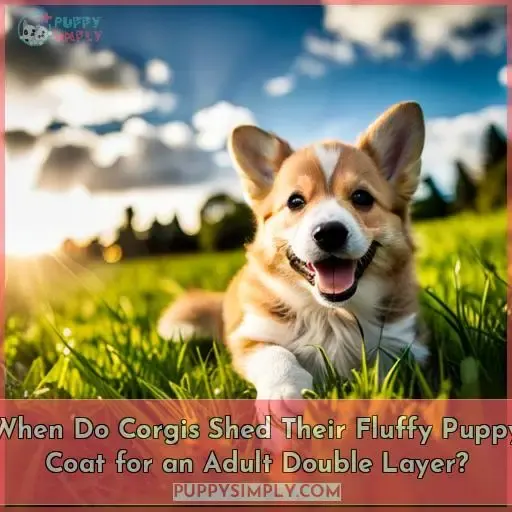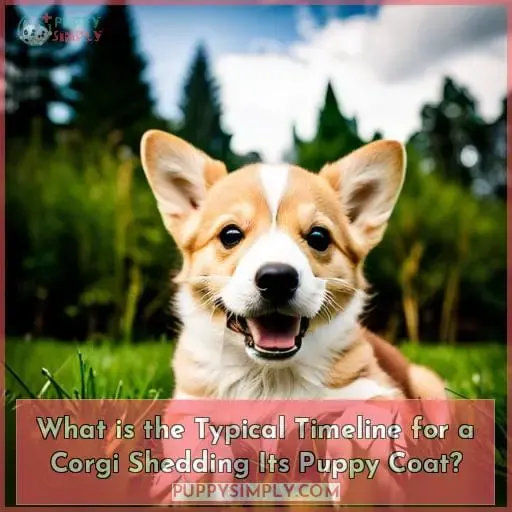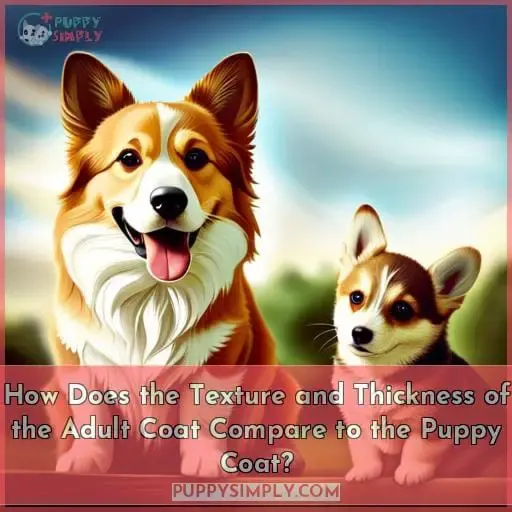This site is supported by our readers. We may earn a commission, at no cost to you, if you purchase through links.
 Imagine the joy of owning a fluffy Corgi puppy, only to be bombarded with their never-ending shedding! But fear not, because in this article we will unravel the mystery of when Corgis shed their puppy coats and transition into an adult double layer.
Imagine the joy of owning a fluffy Corgi puppy, only to be bombarded with their never-ending shedding! But fear not, because in this article we will unravel the mystery of when Corgis shed their puppy coats and transition into an adult double layer.
From understanding the timeline and triggers for shedding to managing health considerations during this process, you’ll gain valuable insights on how to navigate through your furry companion’s shedding journey with ease.
Get ready for a smoother transition – let’s dive in!
Table Of Contents
- Key Takeaways
- What is the Typical Timeline for a Corgi Shedding Its Puppy Coat?
- What Signals or Triggers the Shedding Process?
- How Does the Texture and Thickness of the Adult Coat Compare to the Puppy Coat?
- Are There Any Health Considerations to Ensure a Smooth Transition?
- Frequently Asked Questions (FAQs)
- How long does it take for a Corgi to shed its puppy coat and grow in its adult coat?
- What factors or events trigger the shedding process in Corgis?
- How does the texture and thickness of a Corgi’s adult coat compare to its puppy coat?
- Are there any health considerations or precautions to take to ensure a smooth transition from puppy coat to adult coat in Corgis?
- Are there any specific grooming or care routines that can help with the shedding and transition process in Corgis?
- Conclusion
Key Takeaways
- Corgi puppies shed their puppy coats between 5 to 9 months of age as hormonal changes trigger the shedding process.
- Seasonal changes can also trigger Corgi puppies to shed their puppy coats.
- The Corgi adult coat that grows in place of the puppy coat is coarser, longer, and denser compared to the puppy coat.
- Excessive shedding in Corgi puppies can be a sign of health issues like nutritional deficiencies, allergies, or stress.
What is the Typical Timeline for a Corgi Shedding Its Puppy Coat?
When do Corgis typically start shedding their fluffy puppy coat for an adult double layer?
Around 5 to 9 months of age, Corgis begin the gradual process of shedding their soft puppy fur.
As the seasons change, Corgis shed their coats to regulate their body temperature. During this time, the shedding can seem more pronounced. But not to worry, this is all part of the natural timeline of a Corgi growing its adult coat.
With consistent grooming and a nutritious diet, owners can easily manage this shedding process. Before you know it, your fluffy pup will grow into its coarse and dense adult double layer fur that Corgis are so well known for.
This transition is a milestone for Corgis that owners can take in stride with some simple preparation and care.
What Signals or Triggers the Shedding Process?
You’re noticing more and more tufts of fur around the house as your corgi reaches 5-9 months old. This signals that the shedding process is underway as hormonal changes trigger the puppy coat to fall out in preparation for the adult fur to grow in.
The change of seasons, transitioning from spring to fall, signals hormonal changes in your pup’s body that lead to heavier shedding. As daylight hours shorten and temperatures drop, your corgi’s body reacts by blowing out the lighter puppy fur to make way for a thicker, protective winter coat.
Ensure your corgi’s diet has enough fatty acids, vitamins, and minerals to support healthy skin and fur growth during this shedding season. With the right nutrition and grooming, your pup’s new double layer will grow in beautifully.
How Does the Texture and Thickness of the Adult Coat Compare to the Puppy Coat?
As your pup grows into an adult dog, you’ll notice their coat becomes coarser and denser than when they were a fluffy puppy. This change occurs because the adult double layer is thicker to protect them from weather extremes.
- The texture of the adult coat is rougher and less soft compared to the puppy coat.
- The adult fur is longer in length, giving it a more mature appearance.
- Due to its increased thickness, the adult coat feels heavier when touched or held.
- With this transition comes more shedding as well, as the thicker and denser hair follicles naturally release more loose hairs.
It’s important to understand that these changes are perfectly normal for corgis as they grow into adulthood. Embrace their new textured and thicker coats while ensuring proper grooming practices like regular brushing to keep them healthy and looking their best.
Are There Any Health Considerations to Ensure a Smooth Transition?
As your pup transitions coats, monitor for potential health issues.
Nutritional deficiencies, allergies, stress or hormonal changes can exacerbate shedding.
Discuss any concerns with your veterinarian to ensure your Corgi pup stays happy and healthy.
Nutritional Deficiencies Possible
While transitioning their coat, puppies rely on their diet to supply necessary nutrients for healthy fur growth.
It’s important to provide a balanced and nutritious diet that includes protein, vitamins, and minerals essential for optimal coat health. However, it’s crucial to consult with a veterinarian before giving any supplements as they can be dangerous if not administered properly.
Topical supplements should also be discussed with your vet to ensure safe usage during this transition period. Remember, the overall health of your puppy matters more than just focusing on when or how they shed their puppy fur.
Allergies Can Exacerbate Shedding
You’ll find that allergies in your corgi pup can worsen shedding as their coat transitions.
Environmental and food allergies often first appear around 5-9 months when shedding peaks.
Allergy-related inflammation and itching lead to excess shedding.
Controlling allergens, regular grooming to remove dead hairs, and medications can reduce allergy flare-ups and ease the coat change.
Stress Impacts Shedding Too
Stress can also impact the shedding process, so it’s important to consider your Corgi’s overall health and well-being during this transition.
- Chronic stress may cause hair loss or skin irritation, exacerbating shedding
- Sudden changes in environment or routine can trigger anxiety
- Weight fluctuations, poor appetite are signs of high stress
Monitoring behavioral changes like increased vocalizing or withdrawnness allows you to identify stressors and mitigate their effects on your Corgi’s coat transition. Keeping their world consistent, providing affection and mental stimulation, and discussing any concerns with your veterinarian can help ensure their comfort.
Frequently Asked Questions (FAQs)
How long does it take for a Corgi to shed its puppy coat and grow in its adult coat?
Between 5 to 9 months old, your corgi puppy will shed its soft puppy fur. This transition to the coarser adult coat is a gradual process unique to each pup, so be patient.
Focus on providing excellent nutrition and regular grooming during this time to ensure their new fur grows in full and healthy.
What factors or events trigger the shedding process in Corgis?
Around 5 to 9 months of age, Corgi puppies naturally begin shedding their soft puppy coats as part of the maturation process. Hormonal changes trigger new hair follicles to push out old fur and grow in coarser adult coats better suited for weather protection.
This transition occurs gradually over weeks or months until the new dense double-layer coat is complete.
How does the texture and thickness of a Corgi’s adult coat compare to its puppy coat?
As your Corgi transitions from puppyhood to adulthood, their coat will change in texture and thickness.
The adult fur coat is coarser and denser, providing better protection against the elements.
Are there any health considerations or precautions to take to ensure a smooth transition from puppy coat to adult coat in Corgis?
As their adult coats grow in, ensure your Corgi puppy receives proper nutrition and regular grooming.
Brushing frequently removes dead hairs and distributes natural oils.
Consult your veterinarian about supplements if concerned, but typically patience and attentive care will suffice during this transition.
Are there any specific grooming or care routines that can help with the shedding and transition process in Corgis?
Brush frequently with a de-shedding tool during the transition.
Bathe regularly with a moisturizing shampoo and conditioner.
Check for skin irritation and treat if necessary.
Keep areas clean.
Consult your vet if shedding seems excessive.
Conclusion
Fear not the fluffy pup’s fabulous coat shedding into a formidable double layer. With keen awareness of triggers, timeline, and health precautions, you’ll breeze through this transition.
Monitor nutrition, allergies, and stress levels to curb excessive shedding as they sport their new striking, weather-ready adult coat when corgis shed their puppy coats.
Stay attentive and soon you’ll be frolicking freely with your furry friend sporting their flashy new fur.










